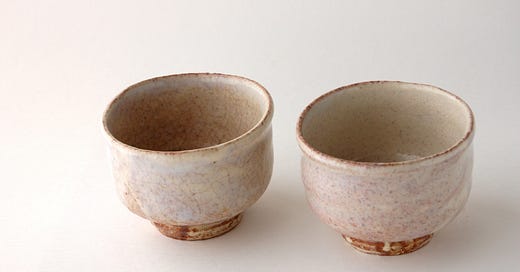September 29, 2024
Hagi-yaki is a unique ceramic originating from a small town in Japan, which holds a fascinating history and beauty.
History of Hagi
Hagi is a small town located in Yamaguchi Prefecture[1], formerly known as Nagato Province. For centuries, these lands were ruled by the samurai Ouchi clan, neighboring the Mori clan[2]. The fate of these lands often depended on the outcomes of single battles and political decisions.
At the beginning of the 17th century, the Mori family received the right to build a castle in Hagi[3]. It was they who brought master potters from Korea, who not only discovered wonderful clay deposits ideal for firing vessels but also taught this art to the Japanese.
Reputation of Hagi-yaki
In Japan, there is a saying: "Ichi Raku, ni Hagi, san Karatsu"[4]. This means: "Raku cups are the best, second are from Hagi, and third from Karatsu". This proverb testifies to the high rank of Hagi ceramics in Japanese culture.
Apparently, Hagi itself is also a place worth recommending for sightseeing, not only because of its great political history and numerous people who changed the course of politics in Japan but also because of its wealth of monuments. Unfortunately, I have never been to Japan, and my love for the art of this country is purely platonic.
Characteristic Features of Hagi-yaki
The ceramics produced in Hagi to this day bears the name Hagi-yaki, which has become a kind of brand for these products. The unique clay (clay from the Hagi region is characterized by high silica content and relatively low iron content) and production technology make Hagi ceramics recognizable at first glance. Beautiful glaze colors give it a very special appearance.
Interestingly, over time and with constant use, the colors of these products change. This happens due to microscopic pores that close as a result of filling the cups with green tea or other liquids[5].
Tradition and Innovation
The most visible feature of Hagi ceramics is a small cut on the edge of the vessel's bottom. This feature has an interesting history. According to ancient shogun regulations, only samurai could use Hagi ceramics. However, the regulations stipulated that if a defective product was produced, it could be sold to anyone.
Clever craftsmen thus began to deliberately cut a small notch on the edge of the vessels' bottoms, which allowed for the immediate recognition of the product as "defective"[6]. Although the samurai era has long passed, this cut is still used today as a distinguishing mark of Hagi-yaki ceramics.
Contemporary Hagi-yaki
Modern Hagi-yaki production impresses with its variety of forms and sizes. While the range is wide, it's the sake and tea cups, as well as rice bowls, that have gained the most fame. These pottery artworks attract attention not only with their affordable price but primarily with their extraordinary beauty. Interestingly, their charm captivates the hearts of both Japanese and foreign ceramics enthusiasts.
The secret of Hagi-yaki's universal appeal lies in its characteristic color palette. Ceramic masters use glazes in subtle, pastel shades. Muted grays, delicate blues, or warm, autumnal browns allow these vessels to easily complement various interior styles, adding a touch of Japanese elegance.
In the world of Japanese art, the provenance of a piece plays a crucial role. For Hagi-yaki connoisseurs, a certificate confirming creation by a renowned master is priceless. Although to an untrained eye, two cups may seem identical, the one bearing the signature of a respected artist can reach staggering prices, even a thousand times higher than the value of a similar but anonymous piece[7]. This demonstrates the great importance attached to tradition and craftsmanship in Japanese culture.
Footnotes:
[1] Yamaguchi Prefecture - one of 47 prefectures in Japan, located in the Chugoku region on the western end of Honshu island.
[2] Ouchi and Mori clans - powerful samurai families that played a significant role in Japanese history during the Sengoku period (1467-1615).
[3] Hagi Castle - built in 1604 by the Mori clan after their defeat in the Battle of Sekigahara.
[4] "Ichi Raku, ni Hagi, san Karatsu" - a Japanese proverb ranking the best tea ceramics.
[5] The phenomenon of color change in Hagi-yaki ceramics - known in Japan as the "seven transformations of Hagi".
[6] The history of the "defect" in Hagi-yaki ceramics - an example of creatively circumventing restrictive regulations in feudal Japan.
[7] The importance of a master's certificate - in Japanese art, the authenticity and provenance of a piece often carry more significance than its outward appearance.
#ceramics #art #Japan




